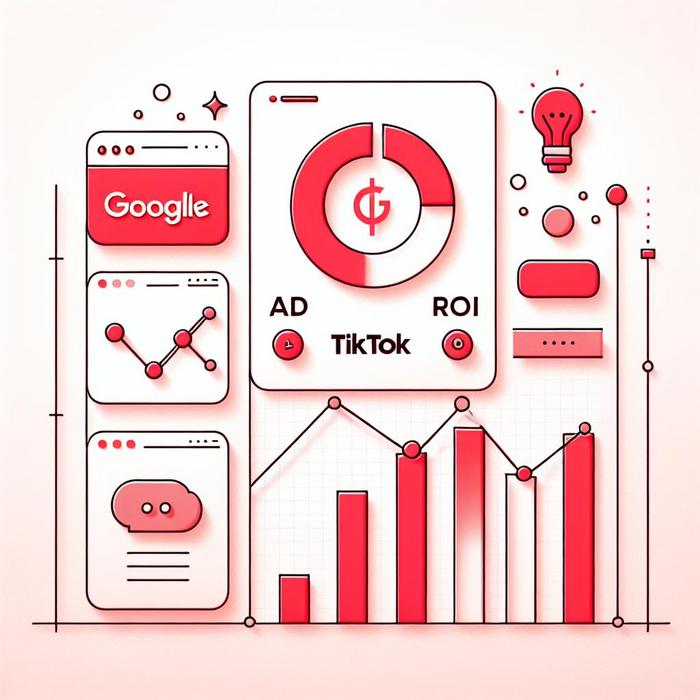Unlocking the Full Potential of your Advertising Efforts
As an experienced digital marketing professional, I’ve encountered many hills and valleys throughout my journey in managing highly successful online advertising campaigns. It is from this perspective that I share actionable insights and innovative strategies that have consistently driven business growth across numerous industries.
Comparing Ad ROI: The Crux of Decision-Making
I’ve built online advertising campaigns on several platforms including Google, Meta, and TikTok . Often, CMOs, CGOs, CFOs, and CEOs have asked me this central question: How can I ensure the highest ROI for our ad campaigns? My answer has always been, arm yourself with a clear understanding of each platform’s performance. This information is golden for strategic decision-making, where every choice can drastically affect the bottom line.
When comparing ROI from Google and TikTok, my experience has shown that there’s no ‘one size fits all.’ Different industries and target audiences respond differently on each platform. This is where strategic decision-making comes into play.
Investing in Google Advertising: The Low-Risk Approach
Google, being the search engine giant, provides an extensive reach. Its advertising platform, Google Ads, lends comprehensive targeting capabilities, making it ideal for businesses with large, diverse target audiences. My managed campaigns on Google have consistently shown a steady, albeit a bit slower, growth in ROI. I’ve found Google to be a less volatile option.
Through my personal experience, I have observed that while managing ad campaigns on Google, CFOs can influence ad budget allocations to align with the organization’s specific objectives, resulting in calculated and optimized expenditure with a constant stream of ROI.
Exploring the Uncharted Terrains of TikTok
In contrast to Google, TikTok, the newcomer in social media, opens the doors to novel and flashy ways of connecting with younger demographics. Although the ad performance might exhibit more volatility, the upside potential is enormous. Moreover, investing in TikTok ads can also lead to significant brand visibility and engagement, given the right creative approach.
The use of real-time data to build ad campaign resilience has been instrumental in my successful TikTok campaigns. With the ability to adjust our strategy to the market’s pulse, we were able to significantly boost our ROI.
Balancing Act: Striking the Right Combination
However, striking the correct balance between these two platforms is key. Leveraging the strengths of both Google and TikTok can yield tangible results that can effectively drive your business growth.
In my experience, a strategy that combines the broad and steady reach of Google with the dynamic and highly engaging nature of TikTok can maximize campaign outcomes. Pooling resources into a composite strategy allows for a flexible approach, adapting quickly to market changes.
Through this approach, I’ve seen organizations scale their global campaigns, seamlessly handling complexities presented by different regional markets. They’ve utilized the multi-regional ad features of Meta and the engaging content of TikTok to cover a broad spectrum of target audiences across the globe.
So, when it comes to Google vs TikTok, it’s not really about choosing one over the other. Rather, it’s about understanding and leveraging the unique strengths of each platform, and building your strategy around that understanding.
The “Meta” Perspective: Shaping Consumer Journeys
The Meta platform, formerly known as Facebook, presents a different dynamic in this arena. As a long-standing presence in the social media landscape, it’s been my observation that the Meta algorithm does more than simply target audiences – it shapes the consumer journey. Let me illustrate this with a success story from my own professional journey.
When managing ads for a high-end fashion brand, we encountered a challenge. Although the brand already had an established online presence, engagements were dwindling and conversion was decreasing. The brand’s unique selling proposition was its focus on ethical, fair-trade practices, which appealed to a select, socially conscious audience. But while this positioned the brand uniquely in the market, it also made it difficult to find a significant number of potential customers who would, in turn, convert into sales.
We decided to run a campaign on Meta. Leaning on the platform’s propensity for shaping consumer journeys, we wanted to not just find an audience, but to create one.
So, what did we do? We tapped into the power of storytelling. We created content that passionately narrated the story of the brand – the process that went into crafting each garment and the lives that were positively impacted as a result. This narrative, conveyed through a variety of ad narratives on Meta was not only engaging. It created a newfound interest and appeal for the brand, significantly improving engagement, and most importantly, leading to a 36% hike in sales.
Achieving Significant Milestones with Data-Driven Strategies
One aspect I cannot stress enough about my work is the pivotal role of data in all digital marketing endeavors. Data, when leveraged strategically, provides the blueprint for successful campaigns.
In managing the PPC campaigns for different platforms such as Google, Meta, and TikTok, I’ve seen how this scenario played out time and again. Each platform offers its unique set of data points. Analyzing those data sets empowers CMOs, CFOs, and other high-level executives to make informed decisions that lead to desired outcomes.
The Big Picture: An All-Encompassing Strategy
To bring these tangents together, here is what I want to emphasize: Google, Meta, and TikTok each have their strengths and nuances. Google reigns supreme when the objective is to reach a broad base with steady, consistent engagement. Meta is your go-to for shaping consumer’s journeys and creating engagement around brand narratives. And if your mission is to capture the next generation with creative and interactive content, nothing beats the influential power of TikTok. But the real game-changer lies in integrating these platforms in a cohesive strategy that maximizes the unique strengths of each.
I’ve seen organizations who wisely leverage Google, Meta, and TikTok to achieve stellar campaigns that cover a broad spectrum of target audiences across the globe. A composite strategy, built on real-time data, consumer behavior, and industry trends fosters flexibility, resilience and ultimately, success on the digital advertising landscape.
This approach ensures steady, incremental growth, further supplemented by the periodic, innovative high-growth potential of Meta and TikTok. Such an integrated approach not only reduces the risk of over-reliance on one platform, but also ensures an expansive reach, effective engagement, and ultimately, a significant increase in ROI.
Embracing the Ever-Evolving Digital Landscape
At the heart of it all is the ability to adapt. Like a surfer balancing on a wave, riding the trends of the ever-fluid digital landscape requires balance, foresight, and above all, the readiness to seize opportunities as they present themselves.
My experiences underline the fact that success in digital advertising isn’t about choosing one strategy over another, or preferring one platform over the other. It’s about understanding the intricacies of each tool at your disposal, tailoring your strategies to optimize these tools, and maintaining an agile mindset open to continual adjustment and improvement.
Final Thoughts.
The landscape of digital advertising is constantly evolving, with new tools and strategies coming to light each day. By focusing on the nuances of each advertising platform, high-level executives can harness these trends and drive their marketing decisions with an informed perspective. No single approach guarantees success. However, a strategic blend of Google, Meta, and TikTok, combined with a thorough analysis of data, can significantly increase the likelihood of reaching your business goals.









